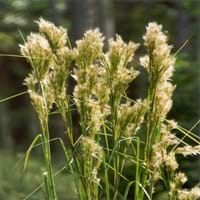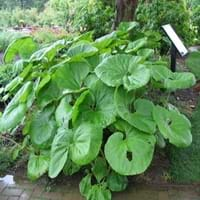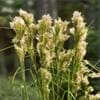Life Span
Perennial
Perennial
Type
Grass
Herbaceous Perennial
Origin
Caribbean, Central America
China, Japan, Korea
Types
Broomsedge Bluestem, Broomsedge
Not Available
Number of Varieties
Not Available
Habitat
ditches, Grassland, Moist Ditches, Moist Soils, Roadsides
Dappled Shade, meadows, Shady Edge, Sunny Edge, Woodland Garden
USDA Hardiness Zone
5-9
5-9
Sunset Zone
H1, 3a, 3b, 4, 5, 6, 7, 8, 9, 14, 15, 16, 17, 18, 19, 20, 21, 22, 23, 24
2a, 2b, 3a, 3b, 4, 5, 6, 7, 8, 9, 10, 14, 15, 16, 17, 18, 19, 20, 21, 22, 23, 24
Habit
Upright/Erect
Clump-Forming
Flower Color
Cream, Green, White
Light Yellow, Ivory
Flower Color Modifier
Bicolor
Bicolor
Fruit Color
Not Available
Not Available
Leaf Color in Spring
Green, Blue Green
Green
Leaf Color in Summer
Light Green
Green
Leaf Color in Fall
Gray Green, Yellow green, Bronze
Green
Leaf Color in Winter
Gold, Tan, Bronze
Not Available
Leaf Shape
Grass like
Ovate
Plant Season
Fall, Winter
Spring, Summer, Fall
Sunlight
Full Sun, Partial Sun
Partial shade, Full Shade
Type of Soil
Clay, Loam, Sand
Clay, Loam, Sand
The pH of Soil
Acidic, Neutral, Alkaline
Acidic, Neutral, Alkaline
Soil Drainage
Average
Poorly Drained
Bloom Time
Late Summer, Early Fall, Fall, Late Fall, Early Winter
Early Spring, Late Winter
Tolerances
Not Available
Wet Site
Where to Plant?
Ground
Container, Ground, Pot
How to Plant?
Root Division, Seedlings
Divison, Seedlings
Plant Maintenance
Medium
Medium
Watering Requirements
Keep ground moist, Water Deeply
Water once every two or three weeks
In Summer
Lots of watering
Lots of watering
In Spring
Moderate
Moderate
In Winter
Average Water
Average Water
Soil pH
Acidic, Neutral, Alkaline
Acidic, Neutral, Alkaline
Soil Type
Clay, Loam, Sand
Clay, Loam, Sand
Soil Drainage Capacity
Average
Poorly Drained
Sun Exposure
Full Sun, Partial Sun
Partial shade, Full Shade
Pruning
Cut or pinch the stems, Remove damaged leaves, Remove dead branches, Remove dead leaves
Remove the old foliage
Fertilizers
All-Purpose Liquid Fertilizer
Use a fertilizer ratio of 16-4-8
Pests and Diseases
Red blotch
No serious insect or disease problems
Plant Tolerance
Drought
Drought
Flower Petal Number
Single
Not Available
Foliage Texture
Coarse
Bold
Foliage Sheen
Matte
Glossy
Invasive
Sometimes
Sometimes
Attracts
Birds, Butterflies
Not Available
Allergy
Not Available
no allergic reactions
Aesthetic Uses
Ground Cover
Bog Garden, Showy Purposes
Beauty Benefits
Not Available
Not Available
Environmental Uses
Air purification, Food for animals, Food for birds, Provides ground cover, Wildlife
Air purification
Medicinal Uses
Not Available
Antiasthamatic, Antispasmodic, Expectorant, Poultice
Part of Plant Used
Seeds
Flowers, Stem
Other Uses
Used as Ornamental plant
Can be boiled and seasoned, pickled, Used as umbrellas by Japanese children, Used as walking sticks, Used like rhubarb
Used As Indoor Plant
No
No
Used As Outdoor Plant
Yes
Yes
Garden Design
Container, Dried Flower/Everlasting, Feature Plant, Mixed Border, Rock Garden / Wall
Bog Garden, Container, Feature Plant, Water Gardens
Botanical Name
ANDROPOGON glomeratus
PETASITES japonicus
Common Name
Bushy Beardgrass, Bushy Bluestem, Bushy Broom Grass
Giant Butterbur, Japanese Butterbur
In Hindi
Bushy Bluestem plant
Giant Butterbur
In German
Bushy Bluestem Pflanze
Riesen Pestwurz
In French
plante buissonnante Bluestem
géant Butterbur
In Spanish
planta arbustiva andropogon
gigante petasita
In Greek
φυτό θαμνώδη BLUESTEM
Giant Butterbur
In Portuguese
planta arbustiva Bluestem
Carrapicho gigante
In Polish
Krzaczaste Bluestem roślin
Giant Lepiężnik
In Latin
Bushy bluestem herba
Giant Butterbur
Phylum
Magnoliophyta
Magnoliophyta
Class
Liliopsida
Magnoliopsida
Order
Cyperales
Asterales
Family
Poaceae
Asteraceae
Genus
Andropogon
Petasites
Clade
Angiosperms, Commelinids, Monocots
Angiosperms, Asterids, Eudicots
Tribe
Andropogoneae
Senecioneae
Subfamily
Panicoideae
Asteroideae
Number of Species
Not Available
Season and Care of Bushy Bluestem and Giant Butterbur
Season and care of Bushy Bluestem and Giant Butterbur is important to know. While considering everything about Bushy Bluestem and Giant Butterbur Care, growing season is an essential factor. Bushy Bluestem season is Fall and Winter and Giant Butterbur season is Fall and Winter. The type of soil for Bushy Bluestem is Clay, Loam, Sand and for Giant Butterbur is Clay, Loam, Sand while the PH of soil for Bushy Bluestem is Acidic, Neutral, Alkaline and for Giant Butterbur is Acidic, Neutral, Alkaline.
Bushy Bluestem and Giant Butterbur Physical Information
Bushy Bluestem and Giant Butterbur physical information is very important for comparison. Bushy Bluestem height is 120.00 cm and width 75.00 cm whereas Giant Butterbur height is 60.00 cm and width 120.00 cm. The color specification of Bushy Bluestem and Giant Butterbur are as follows:
Bushy Bluestem flower color: Cream, Green and White
Bushy Bluestem leaf color: Green and Blue Green
Giant Butterbur flower color: Light Yellow and Ivory
- Giant Butterbur leaf color: Green
Care of Bushy Bluestem and Giant Butterbur
Care of Bushy Bluestem and Giant Butterbur include pruning, fertilizers, watering etc. Bushy Bluestem pruning is done Cut or pinch the stems, Remove damaged leaves, Remove dead branches and Remove dead leaves and Giant Butterbur pruning is done Remove the old foliage. In summer Bushy Bluestem needs Lots of watering and in winter, it needs Average Water. Whereas, in summer Giant Butterbur needs Lots of watering and in winter, it needs Average Water.





